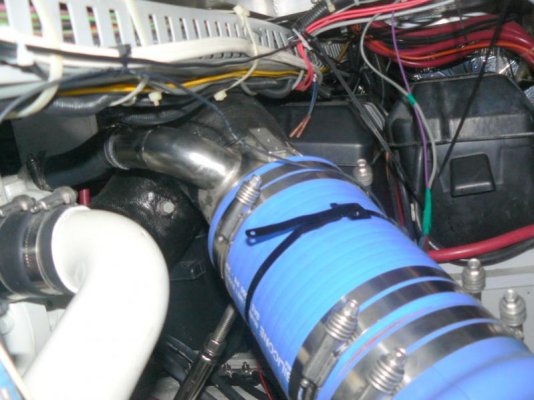timjet
Guru
- Joined
- Apr 9, 2009
- Messages
- 1,920
Looking for advise. Cruising the ICW in S.C. at 1400 rpm I got a raw water temp overheat. The engine is a Cummins 6BT 330 M3 reman with 180 hours. The overheat sensor is a Borel strap type that monitors raw water temp about 1 ft downstream of where the exhaust is mixed with the cooling raw water. Coolant temp indication was normal
I immediately shutdown the engine upon receiving the O/H warning and verified the overtemp with a heat gun. The overheat warning lasted about 5 minutes after the engine was shutdown. I checked the raw water intake strainer for debris but it was clear. About 10 days prior to this leg I had the bottom cleaned and the diver said the engine intakes were so clogged with barnacles he was surprised the engines didn’t overheat. He cleaned them and changed several zincs. Subsequently we have run the engines 15 hours since the intakes were cleaned and this incident. Prior to this cleaning the boat bottom had not been cleaned since May.
After verifying the strainer was clear I jumped into the water to attempt to verify the intake was clear but due to the tannin in the water and the very swift current I couldn’t locate the intakes. While in the water with both engines running in neutral at idle and then at 1500 rpm, I checked both engines raw water flow out the exhaust and they seemed to be the same.
I continued our cruise with both engines running at 1400 rpm and verified with a heat gun the port engine exhaust hose at the location of the overheat sensor was again starting to rise. I increased rpm to 2300 rpm for about 5 minutes and got no overheat warning. I monitored coolant temp carefully and it was normal. After 5 minutes I reduced rpm to 1400 and checked the exhaust tube at the sensor location. Heat gun read 100 deg. Pretty much the same as the other engine.
We continued on to our destination that day at 1400 rpm, another 5 hours, with no issues and no additional overheat warning.
So what to do.
The black band on the blue tube is the overheat sensor.
I immediately shutdown the engine upon receiving the O/H warning and verified the overtemp with a heat gun. The overheat warning lasted about 5 minutes after the engine was shutdown. I checked the raw water intake strainer for debris but it was clear. About 10 days prior to this leg I had the bottom cleaned and the diver said the engine intakes were so clogged with barnacles he was surprised the engines didn’t overheat. He cleaned them and changed several zincs. Subsequently we have run the engines 15 hours since the intakes were cleaned and this incident. Prior to this cleaning the boat bottom had not been cleaned since May.
After verifying the strainer was clear I jumped into the water to attempt to verify the intake was clear but due to the tannin in the water and the very swift current I couldn’t locate the intakes. While in the water with both engines running in neutral at idle and then at 1500 rpm, I checked both engines raw water flow out the exhaust and they seemed to be the same.
I continued our cruise with both engines running at 1400 rpm and verified with a heat gun the port engine exhaust hose at the location of the overheat sensor was again starting to rise. I increased rpm to 2300 rpm for about 5 minutes and got no overheat warning. I monitored coolant temp carefully and it was normal. After 5 minutes I reduced rpm to 1400 and checked the exhaust tube at the sensor location. Heat gun read 100 deg. Pretty much the same as the other engine.
We continued on to our destination that day at 1400 rpm, another 5 hours, with no issues and no additional overheat warning.
So what to do.
The black band on the blue tube is the overheat sensor.



